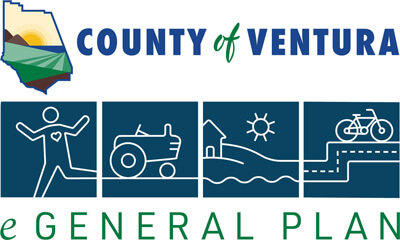The County shall develop a program that encourages sales and distribution of regionally-grown (in Ventura County or neighboring counties of Los Angeles, Santa Barbara, or Kern) produce to local retailers, restaurants, and markets, and encourage chain stores to develop local distribution centers. The program will encourage residents to select locally grown food products for freshness, local economic development benefits, and reduced greenhouse gas (GHG) emissions.
2020-2025
HAZ-O Solar Concentration Restriction
The County shall modify the NCZO and CZO, if necessary, to prohibit the placement and use of facilities that use solar concentration for generation of commercial power that could generate glare and potential to disable pilots and impact flight or test operations at Naval Base Ventura County.
HAZ-Q Standards for Solar Photovoltaic (PV) Carports in County Lots
The County shall establish feasible standards for inclusion of solar PV carports in County-owned parking lots.
HAZ-T Cool Roof Ordinance
The County shall adopt a Cool Roof Ordinance that exceeds the prescriptive cool roof requirements of the 2019 California Building Energy Efficiency Standard for Residential and Nonresidential Buildings by 25 percent (California Energy Code). Under a Cool Roof Ordinance, the County would require new construction to replace or re-coat 2,500 square feet for nonresidential and 1,250 square feet of roof space for residential buildings, or 72.5 percent or more of roofs.
HAZ-U Incentive Program for Passive Solar Home Design and Use of Green Roofs and Rooftop Gardens
The County shall develop incentive programs to promote passive solar home design and the use of green roofs and rooftop gardens when feasible. The program shall include but may not be limited to, permit streamlining and permit fee reductions to apply passive solar home design to future residential buildings.
HAZ-W Incentive Programs for Solar Photovoltaic (PV) Canopies
The County shall establish incentive programs, which may include rebate programs, permit fee reductions, and tax deductions, to incentivize the installation of solar photovoltaic (PV) carports in existing and future parking lots.
